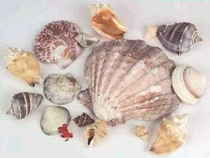
Georgia Symbols
Georgia State Sea Shell
Knobbed Whelk

(Busycon carica gmelin)
Adopted on April 16, 1987
Georgia House of Representatives and the Senate, declared "the Knobbed Whelk, Busycon carica, is designated as the official Georgia seashell." The approval date was April 16, 1987. Christened the Georgia state seashell, the knobbed whelk is a whorled shell, eight inches long at maturity, displaying heavy spines, many knobs, and an orange or red mouth. Minerals in Georgia coastal waters cause ocher striations on the sand-colored, semi-gloss surface. This marine snail shell is found all along Georgia's shoreline, out to 30 feet of water.
Iin 1995, New Jersey also selected the shell of the knobbed whelk as its official state shell.
Georgia State Sea Shell: Knobbed Whelk

The Knobbed Whelk, also known as the conch shell. Busycon carica was described by Gmelin in 1791. It is one of approximately fourteen recognized species (depending on how you fell about subspecies and forms) of the subfamily Bucyconinae, in the family Melongenidae. This subfamily has been a conspicuous component of the marine gastropod fauna of eastern North America through most of the Cenozoic. Whelks have flourished in this region of the Atlantic Ocean since the lower Miocene (approximately 30 million years ago). Today the Knobbed Whelk is a common predator of the intertidal mudflats, and can be found offshore to 26 fathoms.
Shell Character
The Knobbed Whelk has a spiral shell with knobs (or spines) along its shoulder. The whelk's mantle, a thin layer of tissue located between the body and the shell, creates the shell. The whelk builds the hard shell from calcium carbonate that it extracts from the seas. The shell is light gray to tan, and often has brown and white streaks. Knobbed whelks grow to eight or nine inches in shallow water along the coast from Massachusetts to northern Florida. Where they are often a conspicuous gastropod of the bays and estuaries. These animals begin life as small, ~4mm long, crawling snails. Each individual is either male or female, and reach maturity in 3 to 5 years. An adult female will be much larger than a male of the same age.
Anatomy
The soft body is divided into the head, the visceral mass, and the foot (which is small). The Knobbed Whelk has two pairs of tentacles on the head; it has a light-sensitive eyespot located on each of the larger tentacles. The smaller pair of tentacles is used for the sense of smell and the sense of touch.
Diet
Like lightning whelks, knobbed whelks feed on clams, and the females lay strings of egg capsules attached by one end in the sand. They will use
their shell's lip to chip and pry the valves of their prey apart. Once there is sufficient room, they insert their proboscis and begin feeding. This
method of feeding causes a significant amount of damage the shell, and may account for the limited growth of adult shells. Instead of growing, they
must spend their time and energy repairing their shells. In intertidal waters, the snails are active throughout the day.
Reproduction
Twice a year in the southern part of their range (April-May and September-October in Georgia) and once a year in the north, the snails gather in
the estuaries to mate. After mating the female will remain to lay an egg case.
Whelk eggs resemble a telephone cord but actually consist of a number of separate capsules attached to a "string". Each capsule may contain from 0-20
eggs depending on the species of whelk and the location of the capsule on the string. Frequently the first 5-15 capsules are empty, with the number
of eggs per subsequent capsule increasing toward the end of the string. Since the beginning of the string is buried in the substrate as an anchor and
the eggs may not be able to survive under the substrate, the female may be conserving energy by not placing eggs into these capsules. Energy conservation
is very important at this stage in the female's life; laying a string of over 100 capsules may take days to produce! This process can be very strenuous
to the female!
Most marine mollusks have external fertilization of eggs in the water column, followed by a planktonic larval development phase. However, when the
female whelk deposits egg capsules, the embryos inside are already fertilized. This is because fertilization is internal in these species of whelks.
This makes them unique compared to most mollusks in that the young hatch out of these capsules as fully formed juveniles.
Georgia House Resolution No. 130
KNOBBED WHELK - DESIGNATION AS THE GEORGIA OFFICIAL STATE SEASHELL. No. 42 (House Resolution No. 130).
A RESOLUTION
Designating the Knobbed Whelk as the official state seashell; and for other purposes.
WHEREAS, this state has many official symbols but does not yet have a state seashell; and
WHEREAS, Busycon carica, commonly known as the Knobbed Whelk, is found naturally in the coastal waters of Georgia; and
WHEREAS, this beautiful shell is commonly found all along Georgia's shoreline; and
WHEREAS, this shell is an attractive, whorled shell with heavy spines and many knobs and has a semiglossy surface characterized by ocher striations
resulting from the minerals present in the coastal waters of Georgia and an orange to red mouth; and
WHEREAS, the Knobbed Whelk is approximately eight inches long when fully mature and is found from the shoreline to 30 feet of water; and
WHEREAS, designating a state seashell will encourage citizens of the state and visitors alike to visit the beautiful beaches and coastal waters of
the state.
NOW, THEREFORE, BE IT RESOLVED BY THE GENERAL ASSEMBLY OF GEORGIA that the Knobbed Whelk, Busycon carica, is designated as the official Georgia seashell.
Approved April 16, 1987.
Taxonomic Hierarchy: Knobbed Whelk
Kingdom: Animalia
Phylum: Mollusca
Class: Gastropoda
(unranked): clade Caenogastropoda
clade Hypsogastropoda
clade Neogastropoda
Superfamily: Buccinoidea
Family: Buccinidae
Subfamily: Busyconinae
Tribe: Busyconini
Genus: Busycon
Species: B. carica







